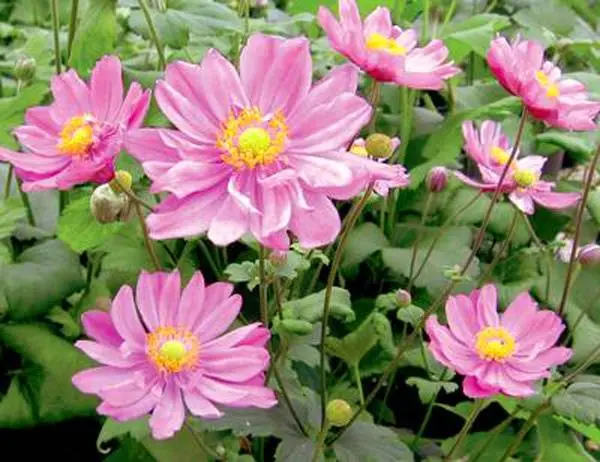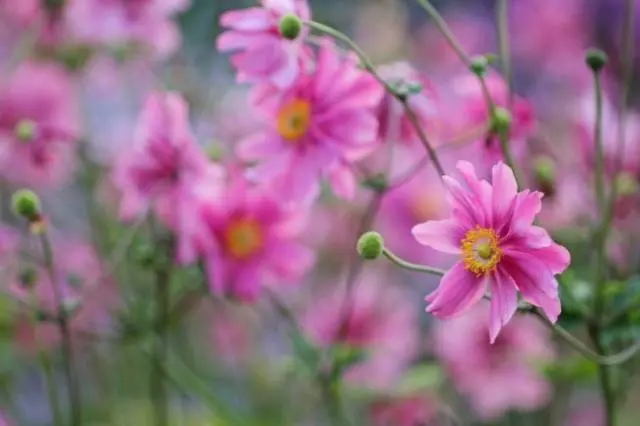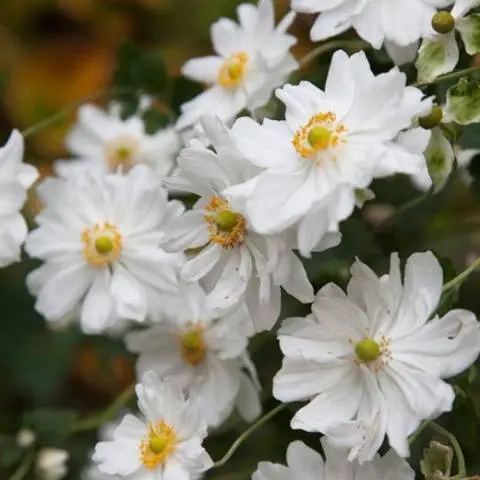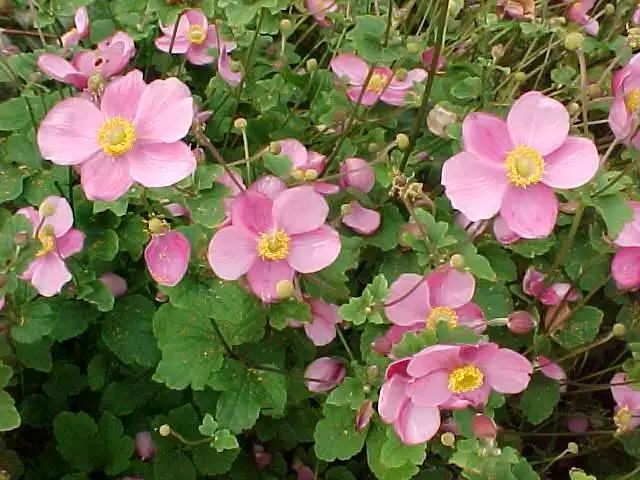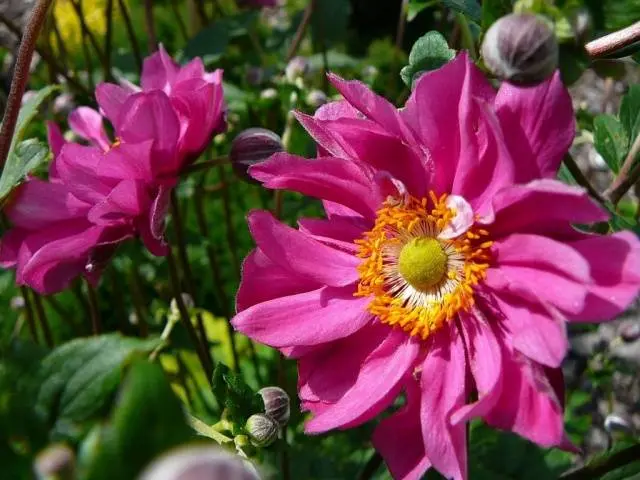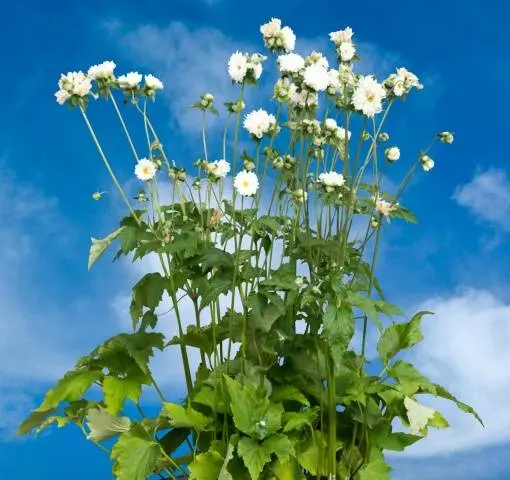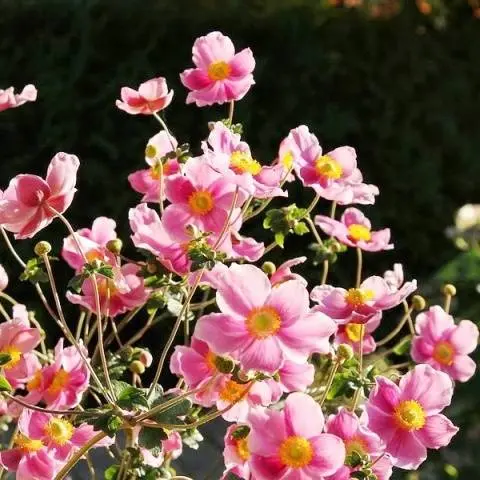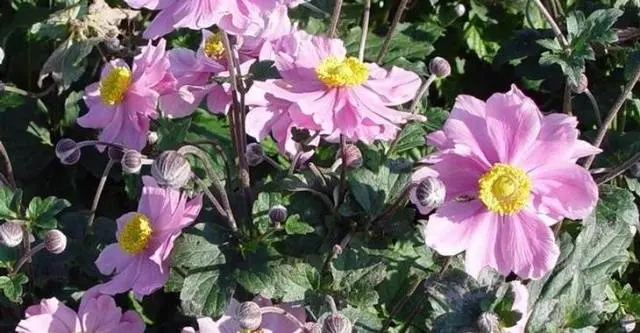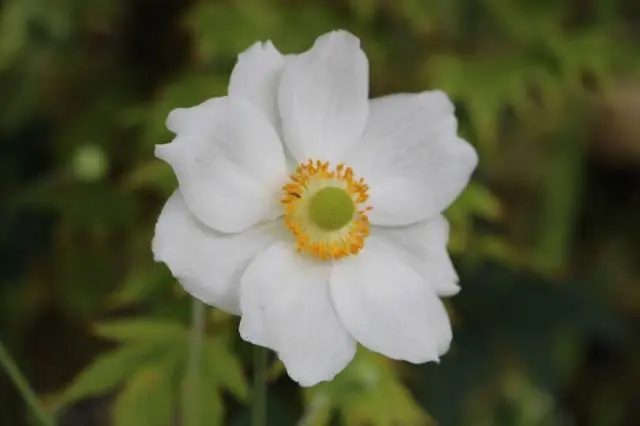Contents
Among the plants blooming at the end of the season, the autumn anemone stands out favorably. This is the tallest and most unpretentious of anemones. She is also one of the most attractive. Of course, in the autumn anemone there is no catchy, bright crown-shaped beauty, which immediately catches the eye and sets it apart from other flowers. But, believe me, when you approach a bush of Japanese or hybrid anemone, you will not be able to take your eyes off the elegant plant for a long time.
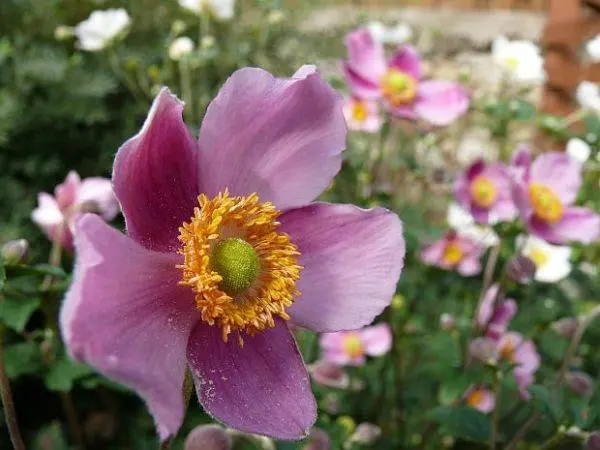
Of course, each flower is beautiful in its own way. But autumn anemones deserve more attention than our gardeners give them. They seem to have stepped out of traditional Japanese-style paintings. The beauty of autumn anemones is exquisite and airy, despite their impressive size. At the same time, the anemone does not cause trouble for the owners and can grow with little or no care.
Types and varieties of autumn anemones
This group includes four species and one subgroup of rhizomatous anemones:
- Japanese
- Hubei;
- vine-leaved;
- felt;
- hybrid.
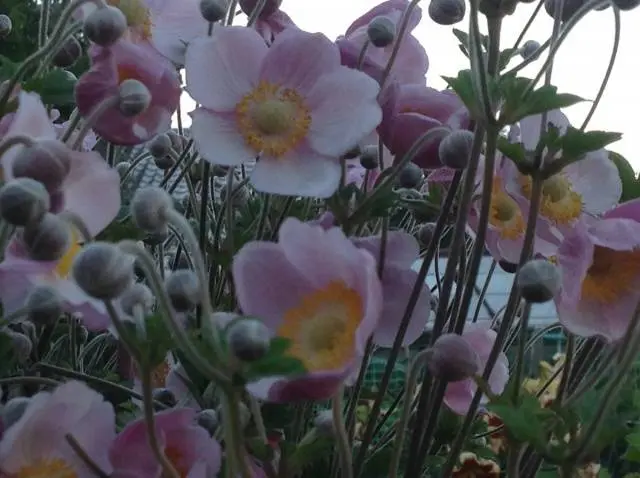
They usually go on sale under the general name “Japanese anemone”. This is due to the fact that these anemones are really similar to each other, and it is difficult for a layman to understand the differences. In addition, in fact, garden centers most often sell a hybrid anemone, obtained from wild relatives living in China, Japan, Burma and Afghanistan.
Let’s take a closer look at the autumn species and varieties of anemones.
Japanese
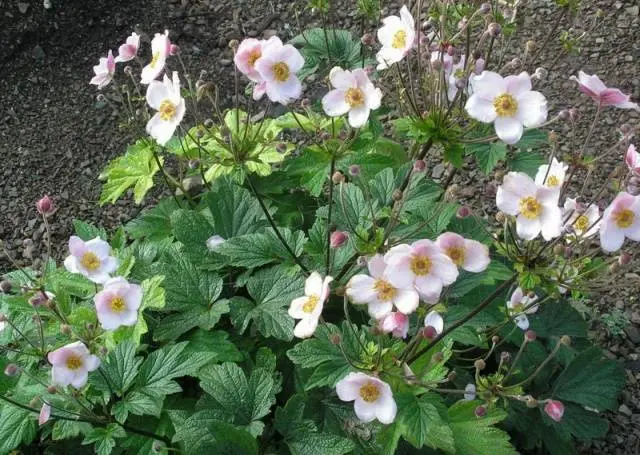
Some sources claim that Japanese anemone and Hubei anemone are one species. It is believed that the anemone came to the Land of the Rising Sun from China during the Tang Dynasty (618-907), where it was introduced and underwent some changes. But since even among scientists there is no single opinion on this issue of unity, and the flowers really have differences, we will give their descriptions separately.
Japanese anemone is a perennial herbaceous plant with creeping, horizontally arranged rhizomes. In species plants, the height reaches 80 cm, varieties can grow from 70 to 130 cm. The leaves of this anemone are thrice pinnately dissected, with serrated segments, painted green with a gray tint. In varieties, they achieve that the shade is bluish or silvery.
Simple anemone flowers are collected in groups at the ends of branched stems, in natural conditions they are painted white or pale pink. The buds open in early autumn. Varietal anemones have flowers of brighter colors, they can be semi-double.
Japanese anemone prefers loose, moderately fertile soils, but if necessary, is content with any soil. It is easy to care for, for the winter it requires shelter only in regions with severe winters with little snow. It grows well on its own, but does not like transplants.
Pay attention to the varieties of Japanese anemones:
- Queen Charlotte – rich pink velvety anemone flowers with a diameter of 7 cm strew a bush 90 cm high;

- Prince Heinrich – the height of the anemone can reach from 90 to 120 cm, the flowers are large, red, but in poor dry soil they can become pale;

- Whirlwind – semi-double snow-white flowers appear at the end of summer, anemone grows up to 100 cm;

- September Charm – grows above 100 cm, large simple pink anemone flowers are decorated with a golden center;

- Pamina – one of the early Japanese anemones of red, sometimes even burgundy, blooms at the end of July and grows no higher than a meter.

Hubei
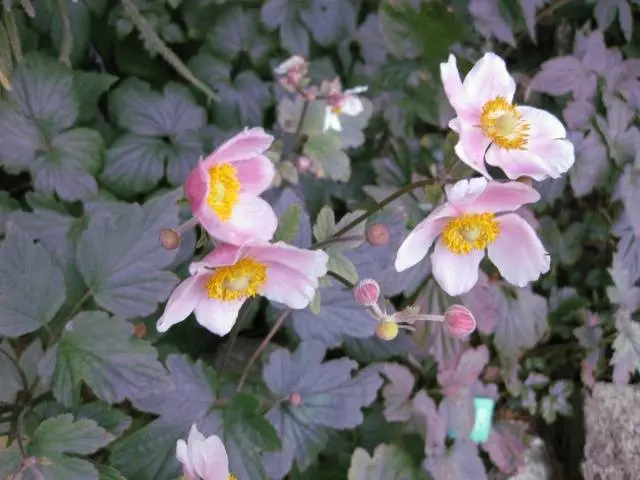
Unlike the previous species, it grows up to one and a half meters, its flowers are smaller, and the large leaves are dark green. Anemone blooms in late summer or early autumn, painted white or pink. The varieties of this anemone were created so that the bushes were undersized and more suitable for home gardening.
Popular varieties:
- Tikki Sensation – from August until frost, white double flowers bloom on miniature anemones up to 80 cm high (silver medal at the international exhibition Plantarium-2017);

- Crispa – anemone is distinguished by corrugated leaves and pink flowers;

- Prekoks – anemone with crimson-pink flowers;

- Splendens – anemone leaves are dark green, flowers are red.

vine-leaved
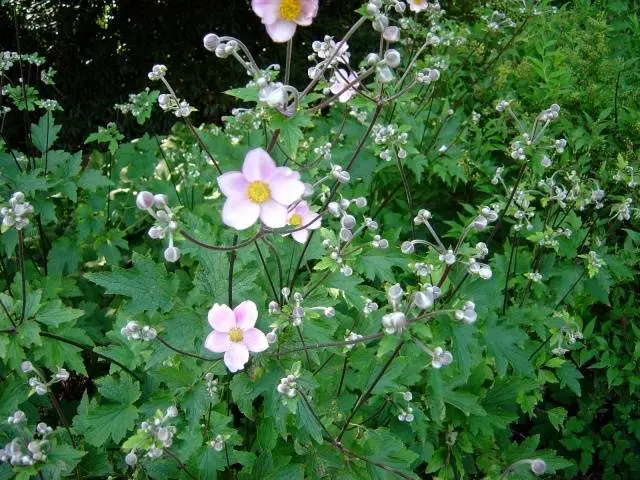
This anemone came to Europe from the Himalayas and is found at an altitude of up to 3 thousand meters. It prefers sandy, moist soils. Anemone leaves can be five-lobed and really look like grape leaves. Flowers modest, white or slightly pink. While the anemone itself grows up to 100 cm, the size of the leaf plate can reach 20 cm.
This anemone is rarely grown in our gardens, but is involved in the creation of hybrids.

felt
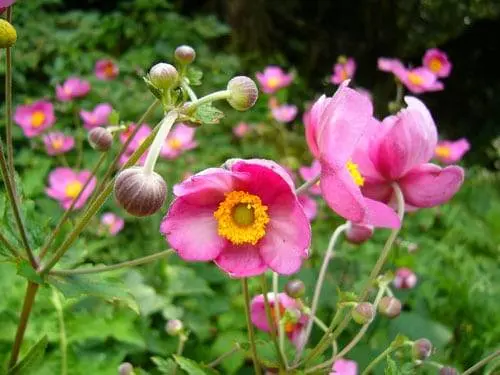
Anemone of this species begins to bloom from late summer or early autumn, grows up to 120 cm in nature. It is believed that it is the most cold-resistant and hardy to adverse external influences. In the southern regions, this anemone is not recommended to be grown. Anemone leaves are pubescent on the underside, few flowers are pale pink.
Of the varieties, Roboutissima can be distinguished up to 120 cm high and with pink fragrant flowers.
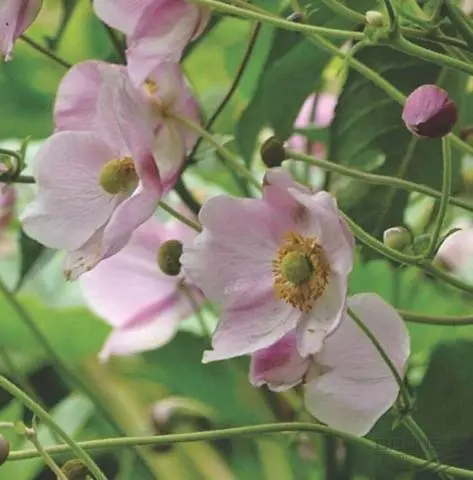
Hybrid
This anemone is a hybrid of the anemones listed above. Often varieties of species are also included here, which results in some confusion. But as you can see in the photo, the anemones are really very similar. The leaves of a hybrid anemone usually do not rise above the ground by more than 40 cm, while the flower stalks rise to a meter. The buds appear for a long time, their color and shape are varied.
Anemone hybrids prefer abundant watering and grow well in loose, fertile soils. On poor soils, flower size and color suffer.
Look at the photo of popular hybrid anemone varieties:
- Serenade – double or semi-double pink flowers reach a diameter of 7 cm, an anemone bush – up to a meter;

- Lorelai – an anemone about 80 cm high is decorated with flowers of a rare silver-pink color;

- Andrea Atkinson – dark green leaves and snow-white flowers decorate an anemone up to 1 m high;

- Lady Mary is a miniature anemone, not even reaching a height of half a meter, decorated with white single flowers, and grows very quickly.

caring for autumn anemones
Planting and caring for autumn-blooming anemones is easy.
Site Selection
Autumn anemones can grow in partial shade. Where you place them depends on the region. In the north, they feel good in the open, but in the southern regions they will suffer with an excess of sun. All anemones do not like the wind. Take care to protect them, otherwise the tall, delicate autumn anemones may lose their petals and lose their decorative effect. They need to be planted so that they are covered by trees or shrubs from the windy side.
To soils, all anemones, except for hybrid ones, are not very demanding. Of course, completely developed soil will not suit them, but there is no need to be zealous with manure.
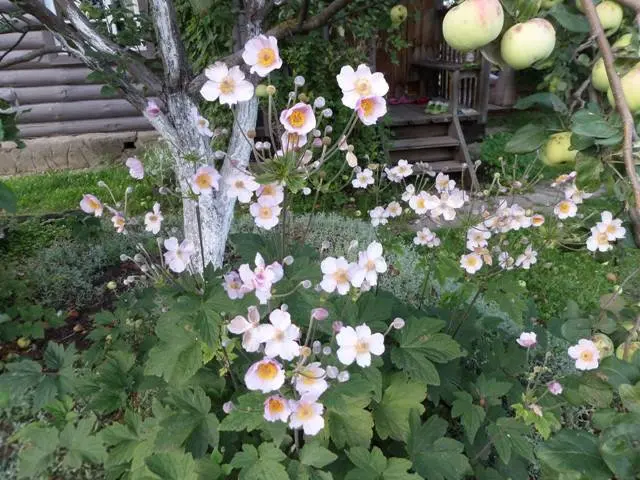
Planting, transplanting and reproduction
Anemones have fragile roots and do not like transplants. Therefore, before lowering the rhizome into the ground, think carefully about whether you want to move the anemone to another place in a year.
It is best to plant anemones in the spring. Autumn species and varieties may even bloom at the end of the season. Autumn planting is undesirable, but possible for rhizomatous anemones. Just finish the earthworks well before the frost, so that the roots have time to get a little comfortable in the ground.
The soil for planting anemones is dug up, weeds and stones are removed. Poor soils are manured, ash or dolomite flour is added to acidic ones. Planting is done so that the rhizome of the anemone is buried in the ground by about 5 cm. Then watering and mandatory mulching are carried out.
Anemone transplantation is best combined with dividing the bush. This is done in early spring, when shoots have just appeared on the surface, and no more than once every 4-5 years.
The main thing is to do everything carefully, trying not to injure. The anemone is dug up, freed from excess earth and the rhizome is divided into parts. Each must have at least 2 points of growth. If necessary, in the spring, you can carefully dig out the lateral offspring of anemones and transplant them to a new place.
Seasonal care
When growing anemones, the main thing is watering. The soil should be well-drained, as moisture stagnation at the roots is unacceptable. In the spring, watering is done no more than once a week, and only when there is no rain for a long time. In hot, dry summers, it is advisable to moisten the soil daily. Watering is especially important during bud formation.

If, when planting in autumn or spring, you brought a lot of organic matter under the anemones, you can not fertilize them until the end of the first growing season. In subsequent years, during the formation of buds, feed the anemone with a mineral complex, and in late autumn, mulch with humus – it will serve as spring fertilizer.
Further care consists in manual weeding – anemone roots are located close to the surface. Therefore, loosening the soil is not carried out, instead it is mulched.
Preparation for winter
In autumn, the aerial part of the anemone is cut off only in the southern regions; for other regions, this operation is postponed to spring. The soil is mulched with manure, compost, hay or peat. Where winters are harsh and there is little snow, the anemone can be covered with spruce branches and spandbond.
Conclusion
Graceful, delicate autumn anemones will brighten up your autumn garden and do not require much care.










